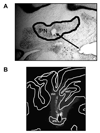Cerebellar inactivation impairs cross modal savings of eyeblink conditioning
- PMID: 19331453
- PMCID: PMC2679372
- DOI: 10.1037/a0014483
Cerebellar inactivation impairs cross modal savings of eyeblink conditioning
Abstract
Eyeblink conditioning using a conditioned stimulus (CS) from one sensory modality (e.g., an auditory CS) is greatly enhanced when the subject is previously trained with a CS from a different sensory modality (e.g., a visual CS). The enhanced acquisition to the second modality CS results from cross modal savings. The current study was designed to examine the role of the cerebellum in establishing cross modal savings in eyeblink conditioning with rats. In the first experiment rats were given paired or unpaired presentations with a CS (tone or light) and an unconditioned stimulus. All rats were then given paired training with a different modality CS. Only rats given paired training showed cross modal savings to the second modality CS. Experiment 2 showed that cerebellar inactivation during initial acquisition to the first modality CS completely prevented savings when training was switched to the second modality CS. Experiment 3 showed that cerebellar inactivation during initial cross modal training also prevented savings to the second modality stimulus. These results indicate that the cerebellum plays an essential role in establishing cross modal savings of eyeblink conditioning.
(c) 2009 APA, all rights reserved.
Figures







Similar articles
-
Cross-modal savings in the contralateral eyelid conditioned response.Behav Neurosci. 2015 Dec;129(6):683-91. doi: 10.1037/bne0000105. Epub 2015 Oct 26. Behav Neurosci. 2015. PMID: 26501170 Free PMC article.
-
Pontine stimulation overcomes developmental limitations in the neural mechanisms of eyeblink conditioning.Learn Mem. 2005 May-Jun;12(3):255-9. doi: 10.1101/lm.91105. Learn Mem. 2005. PMID: 15930504 Free PMC article.
-
Eyeblink conditioning in rats using pontine stimulation as a conditioned stimulus.Integr Physiol Behav Sci. 2004 Jul-Sep;39(3):180-91. doi: 10.1007/BF02734438. Integr Physiol Behav Sci. 2004. PMID: 15929500 Free PMC article.
-
The effects of ethanol on the developing cerebellum and eyeblink classical conditioning.Cerebellum. 2004;3(3):178-87. doi: 10.1080/14734220410017338. Cerebellum. 2004. PMID: 15543808 Review.
-
Cannabinoid agonist administration within the cerebellar cortex impairs motor learning.Neurobiol Learn Mem. 2020 Apr;170:106896. doi: 10.1016/j.nlm.2018.06.015. Epub 2018 Jun 30. Neurobiol Learn Mem. 2020. PMID: 29964164 Free PMC article. Review.
Cited by
-
Medial auditory thalamic input to the lateral pontine nuclei is necessary for auditory eyeblink conditioning.Neurobiol Learn Mem. 2010 Jan;93(1):92-8. doi: 10.1016/j.nlm.2009.08.008. Epub 2009 Aug 23. Neurobiol Learn Mem. 2010. PMID: 19706335 Free PMC article.
-
Cross-modal savings in the contralateral eyelid conditioned response.Behav Neurosci. 2015 Dec;129(6):683-91. doi: 10.1037/bne0000105. Epub 2015 Oct 26. Behav Neurosci. 2015. PMID: 26501170 Free PMC article.
-
Establishment and transfer of classical eyeblink conditioning using electrical microstimulation of the hippocampus as the conditioned stimulus.PLoS One. 2017 Jun 2;12(6):e0178502. doi: 10.1371/journal.pone.0178502. eCollection 2017. PLoS One. 2017. PMID: 28575003 Free PMC article.
-
Comparison of auditory and visual conditioning stimuli in delay eyeblink conditioning in healthy young adults.Learn Behav. 2009 Nov;37(4):349-56. doi: 10.3758/LB.37.4.349. Learn Behav. 2009. PMID: 19815931
-
Examination of bilateral eyeblink conditioning in rats.Behav Neurosci. 2009 Dec;123(6):1346-52. doi: 10.1037/a0017314. Behav Neurosci. 2009. PMID: 20001118 Free PMC article.
References
-
- Aizemen CD, Linden DJ. Rapid, synaptically driven increases in the intrinsic excitability of cerebellar deep nuclear neurons. Nature Neuroscience. 2000;3(2):109–111. - PubMed
-
- Allen MT, Chelius L, Masand V, Gluck MA, Myers CE, Schnirman G. Integrative Physiological & Behavioral Science. 2002;37(3):188–124. - PubMed
-
- Attwell PJ, Cooke SF, Yeo CH. Cerebellar function in consolidation of a motor memory. Neuron. 2002;34(6):1011–1020. - PubMed
-
- Attwell PJ, Ivarsson M, Millar L, Yeo CH. Cerebellar mechanisms in eyeblink conditioning. Annals of the New York Academy of Sciences. 2002;978:79–92. - PubMed

